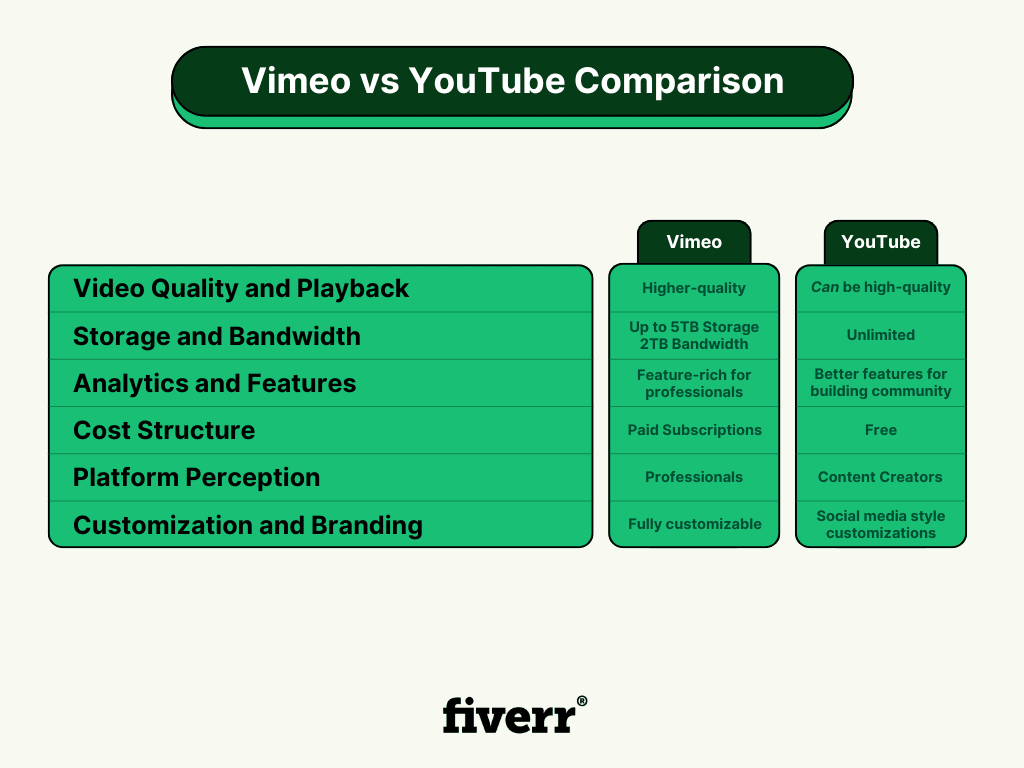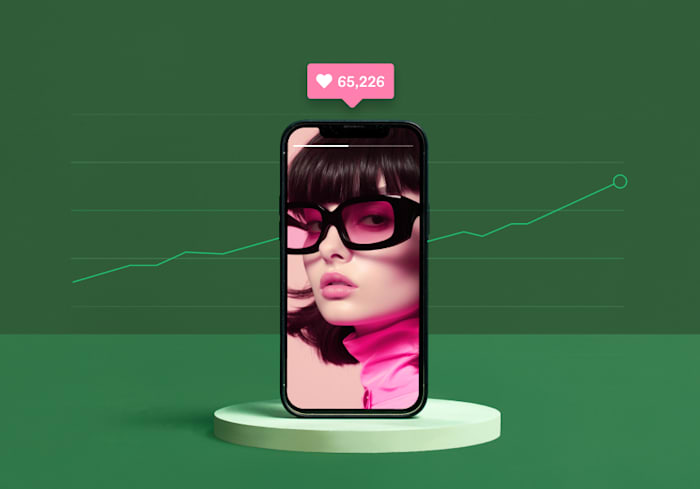Vimeo vs YouTube: Differences and How to Choose Between Them
A detailed comparison of YouTube and Vimeo to help you pick the right video platform.
 April 7, 2025
April 7, 2025 10 minute reading
10 minute reading
When creating video content as part of a marketing strategy, one key question to ask is, "Where do I post my videos?"
If you've clicked on this guide, chances are you've narrowed your choices down to Vimeo and YouTube. Both platforms seem pretty similar—they both host video content and have feedback features (AKA comments). However, beyond those two points, the platforms are quite different.
In this guide, we'll be giving a detailed comparison of the two platforms to help you decide which is the best option for your video marketing strategy.
YouTube overview
When you think about video content, YouTube probably comes to mind. It's the most well-known video content website in the world, having crossed the 2 billion unique monthly active users milestone back in 2019. It’s often referred to as the second-largest search engine.
Since Google owns YouTube, its videos are some of the most discoverable on search engines with the right YouTube SEO practices. As a result, the platform has a mind-boggling potential reach beyond signed-in YouTube users.
YouTube also offers various content types because of its massive user base and discoverability. You may have heard this in response to a question you’ve had: "If you have a question, someone on YouTube has probably answered it."
This means that some of the most popular categories of YouTube videos include:
Education/Tutorials
Music/Musicians
Art (like painting, photography, and short films)
Product reviews
Entertainment (like pranks, challenges, compilation videos, and comedy)
Of course, these aren't the only categories, but generally, these are content types you'll typically find on YouTube. While it may seem obvious, content that includes violence, sexual/adult content, drugs and alcohol, hate speech, and other "dangerous material" is restricted.
But how do people and businesses make money on the platform? YouTube monetization primarily happens through AdSense, which earns ad revenue on your videos through its “Partner Program.”
This happens when channels gain 1,000 subscribers and earn 4,000 long-form public watch hours in the previous 365 days or 10 million Shorts views in the previous 90 days. You must also apply for YouTube channel monetization, though it will notify you when you're eligible.
However, you can earn money through YouTube in other ways. You can:
Create Memberships: A monthly subscription option to offer fans exclusive content.
Supers: Super Chat, Super Stickers, and Super Thanks are tokens of appreciation—fans can use them to buy a highlighted chat or animated message.
Shopping: You can connect an online shop to your channel, which lets you link directly to products in your videos.
These options are available when you:
Hit 500 subscribers.
Upload at least three videos within the previous 90 days.
Have 3,000 public watch hours or 3 million Shorts views.
Finally, you can also use YouTube to promote your business and for affiliate marketing through user-generated content or traditional brand sponsorships. As an example of what's possible, the highest-earning YouTuber in the world is Jimmy Donaldson (MrBeast), who according to Forbes reporting, earned $54 million in 2021.
Vimeo overview
You may or may not have heard of Vimeo before. The video hosting platform has a significantly smaller user base compared to YouTube, at 287 million. Almost 1.3 million of these are paid self-serve subscribers, and it has around 3,800 enterprise clients.
In contrast to YouTube, Vimeo's smaller user base is mostly due to its niche—professional filmmaking and corporate videos. With this more professional user experience in mind, you can expect higher-quality content.
To serve these expectations, Vimeo has a different revenue strategy. This strategy primarily comes from paid self-serve subscribers and enterprise clients. The paid plans are:
Starter: $12 per month billed annually, or $20/month billed monthly.
Standard: $25/m billed annually, or $41/m billed monthly.
Advanced: $65/m billed annually, or $108/m billed monthly.
Enterprise: Contact for quote.
Vimeo also charges separately for its OTT (on demand) suite, at $1 per subscriber per month (or a custom quote for Enterprise clients).
These pricing plans increase the number of overall features you'll have access to. It's worth mentioning some of the technical features that YouTube does not have anything comparable to, which include:
Full video editing tools and video creation tools.
Customization options for URLs and video players.
Replace-in-place video (replace videos but keep URL and analytics).
Review and collaboration tools.
Social analytics alongside engagement analytics.
Better video compression.
Native publishing and live streaming across other platforms, such as Facebook, YouTube, LinkedIn, X, Pinterest, and Shopify.
Password protection for private videos.
Domain-level privacy options.
Some of these are top-cited reasons people said they use Vimeo in our research*:
These are some reasons filmmakers and professional videographers use Vimeo for filmed video production and distribution.
Hire freelance experts for your next YouTube video
Comparison of YouTube and Vimeo
For those of you looking for a quick reference guide, check out the graphic below:

Fiverr
Otherwise, let's compare these two platforms.
Video quality and playback
Winner: Vimeo
Vimeo supports up to 8K, HDR, and Dolby Vision.
YouTube supports 4K and HDR.
One of the more important aspects of any video-sharing platform is video quality and playback. After all, what's the point in creating content with high-quality visuals only for a platform to squash it and reduce the quality?
In our research, the most cited reason for creating Vimeo videos was compression. The Vimeo platform is "less aggressive" compared to YouTube, and many creators notice the difference in quality.
However, the key is codec and bitrate. Using an H264 codec means the video is better formatted for the web, and a lower bitrate (like 18Mb/s for 1080p, or 35Mb/s for 4k) reduces the file size to make playback and streaming smoother.
Storage and bandwidth
Winner: YouTube
YouTube has no contest here. The platform does not limit the number of videos you can upload, though a single upload is limited to 256GB or 12 hours, whichever comes first. In terms of bandwidth, it's also virtually unlimited—it depends on the viewers' internet speeds.
On the other hand, Vimeo has both storage and bandwidth limitations based on the plan you pay for. Each plan has 2TB of bandwidth per month (except Enterprise, which is customized). The storage increases with each plan as follows:
Free: 1GB
Starter: 100GB
Standard: 1TB
Advanced: 5TB
Enterprise: Custom
YouTube wins this comparison since its storage is virtually limitless.
Analytics and features
Winner: Vimeo
Vimeo has come a long way in the last few years to offer a competitive amount of data in terms of video analytics tools. Both platforms offer a similar amount of analytical data—engagement metrics, viewer demographics, and traffic sources, for example.
However, Vimeo just edges out for analytics in business use cases. It can track team-level engagement as well as live event engagement.
Vimeo is also a lot more feature-rich to cater to a variety of business needs. Some of Vimeo's standout features include:
Replace-in-place lets you re-upload a video while keeping the original analytics and URL.
Password protection and other business-focused privacy settings.
Video collaboration.
An OTT and VOD platform if you've got a big production in mind.
Intelligent asset management.
YouTube's main standout feature, on the other hand, is Shorts. If you want to create short-form content with the potential of virality, Shorts is the way to go (unless you compare Shorts vs TikTok).
Additionally, since YouTube is a much more well-known platform, you can hire expert help for YouTube channel management as your channel grows.
Cost structure
Winner: It depends.
YouTube is free to use for creators. You can upload videos at no cost, and if you're eligible, YouTube will pay you to attract viewers (and eyes to their ads). So, what's the real cost?
Well, you grant YouTube a license to use your content for YouTube's own interest. Plus, unless your viewers are YouTube Premium users, your content will have ads.
Vimeo is ad-free. So, instead, Vimeo's business model relies on its paid subscription tiers.
As a result, the platform that wins this comparison depends on your preference. Not having ads was cited as a top reason for using Vimeo—it's important for some creators to not have any disruptions during viewing.
But if you do not necessarily care about ads or if you're doing YouTube for business on a budget, YouTube wins.
Get help sharpening your video editing skills
The perception of each platform
Winner: It depends
Lots of people create YouTube channels with the hopes of generating income as a content creator or influencer. YouTube has the reputation for making this dream a reality for plenty of people. After all, it's in YouTube's best interest to have as many people watching on the platform as possible.
Therefore, being a monetized YouTube creator has an aura of experience with creating content that attracts attention (good and bad).
On the flip side, Vimeo is known for professional, high-quality, and/or artistic productions and "serious filmmaking." One of the common comments about the perception of Vimeo was how offering YouTube links to clients felt "unprofessional."
However, the comparison is subjective here. In the words of Redditor u/microcasio, "You date YouTube in college, you marry Vimeo." So, depending on your needs, the perception of each platform could work in your favor.
Customization and branding
Winner: Vimeo
The only parts of YouTube you can customize on your channel are the layout, profile picture, banner image, channel name, description, and site links. On individual videos, you can add chapters and customize the video title and description.
In comparison, Vimeo lets you customize every part of the video player—colors, logo, thumbnail, the playbar, speed controls, chaptering, and more. You can also build your own OTT platform with customized branding.
As a result, Vimeo wins in this comparison.
Use cases for Vimeo and YouTube
The comparison above makes Vimeo seem like a clear winner overall. However, it highly depends on what you want to use your video content for. So, let's look at a couple of the main use cases.
Professional filmmakers
Vimeo's target audience for creators is professional filmmakers—people who create short and feature-length films. The platform is also partnered with the European Film Academy to present Vimeo "Staff Picks," which can sometimes go on to win third-party film awards.
It's also the better place for professional videographers to highlight their portfolio or deliver client work through privacy controls and direct download features.
Professional filmmakers can (and do) post their content on YouTube, too. YouTube's benefit is its broader discoverability. However, the filmmaking community opts for Vimeo in this use case.
Content creators
An important factor for video creators to consider is your content's discoverability. Your income typically relies on getting views and engagement and promoting your YouTube channel. While Vimeo does have a "Watch" section, it does not come close to YouTube videos in search and in-platform discovery.
Important note: Vimeo no longer organizes or promotes individual user-uploaded videos on vimeo.com in the EU or the UK. This means your content will not be discoverable if you're a creator in these regions.
As a result, YouTube is a much better platform for content creators looking to monetize their videos.
YouTube's monetization options are also much more tailored to content creators. AdSense, Supers, Memberships, and Shopping each contribute to creator income.
On the other hand, you'll need to create either paid-access live events or video subscriptions for creators to monetize on Vimeo—both of which tend to require an existing audience.
Businesses
Both platforms offer worthwhile use cases for businesses. If you want to promote your products and services to a wider audience, YouTube is a great option. It's also a good option for building trust and authenticity in your brand with behind-the-scenes (BTS) videos.
In contrast, if you want to have an internal video content library, Vimeo is a better option thanks to its Enterprise features. For example, company-wide meetings, training and onboarding, and process documentation.
Vimeo is also a better option for hosting videos that you want to embed on your website or on video landing pages since you can customize the player to match your branding.
How to decide on Vimeo vs YouTube
After seeing the comparisons between Vimeo and YouTube and the common use cases above, you should have a good idea of which platform is most suitable for you.
The best approach for deciding which platform to focus on is research. Knowing what type of content you're creating and your target audience will help you a ton.
Create a list of must-haves in terms of features and usability. Then, use that list to compare against the quick-reference comparison graphic in our guide above.
Despite all of this comparison, there's nothing stopping you from using both platforms. A good balance would be to use Vimeo for internal or "owned" content (like your business or personal website) and YouTube for external content.
Find a Video Marketing Expert for Hire
Hire a professional video editor on Fiverr.
Ali Abdaal, one of YouTube's top creators, offers a "Part-Time YouTuber Academy" course and community. On his landing page, he specifically highlights the importance of building systems—AKA outsourcing and YouTube automation.
Unless you're building a full-time production team, your next best option is to hire expert freelancers who can help you with video editing, video art and VFX, sound design, and more (even video advice).
Fiverr allows creators and clients to collaborate on various creative projects. Hire your freelance video production team through Fiverr today.
Vimeo vs YouTube FAQs
Is Vimeo better than YouTube?
It depends. Vimeo is better for professional filmmakers and videographers to host high-quality videos with customizable video players and privacy controls for businesses. This creates a bespoke viewing experience. But, YouTube is better for content discoverability and variety in formats.
What are the disadvantages of Vimeo?
Vimeo's free plan is limited and unsuitable for a larger content library unless you buy a subscription.
Vimeo has a smaller user base, which typically means less exposure.
Vimeo does not have many options for encouraging further action. For example, Vimeo does not offer following or community building.
Why do people post on Vimeo instead of YouTube?
People post on Vimeo for several reasons:
Less aggressive video compression.
Direct video download.
Replace-in-place video management.
A more professional feel.
Video privacy controls.
No ads.
More relaxed copyright enforcement.
And more.
What kind of people use Vimeo?
The two most typical Vimeo users are creative filmmakers and larger corporate businesses. First, creative filmmakers use Vimeo for its higher quality player and fellow filmmaker critique. Second, larger corporate businesses use Vimeo for internal video hosting and live events (like company-wide meetings).
*Methodology: We conducted qualitative coding of 28 responses to a Reddit thread titled "Why is Vimeo used over YouTube?" We generated codes as "mentioned features" and then weighted them as a percentage of total responses.






